-
Cape Festival, Kanyakumari:
Cape Festival - Tamil NaduKanyakumari, also known as "Cape Comorin" is located at the southern most tip of India, where the Bay of Bengal, Indian Ocean and the Arabian Sea meet. A dip in the ocean here is considered holy, but the sea is rough here and not fit for bathing. This is the only place in India, where the sunset and moonrise can be viewed simultaneously on a full moon day.
The Vivekananda memorial set amidst the sea is a place known to give mental emancipation. The Cape festival is celebrated on a large scale for three days at Kanyakumari. The festival is marked by a series of cultural programs.
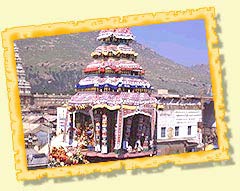
How to get there ?
Air - The nearest airport is at Thiruvananthapuram (80-km), which is well connected with national and International flights. From Thiruvananthapuram, one can take a taxi or bus to Kanyakumari.
Rail - Kanyakumari is well connected by train services with all the places in India. Superfast trains connect the southern most railhead of India with northern cities like Jammu and Delhi. Intercity trains Experience Indian Festivals are running from almost all the southern cities.
Road - Kanyakumari is connected by regular bus services with all the major cities of the state such as Chennai, Pondicherry, Bangalore , Trichy, Madurai, Mandapam (Rameshwaram), Nagercoil, Tuticorin, Tiruchendur, Tiruvelveli, Trivandrum, etc.
Car Festival at Kaliyaperumal Temple in Ariyalur:
Car Festival - Tamil NaduThe Kaliyaperumal temple is a major attraction of Ariyalur. This temple is famous for its "Car festival" which is conducted yearly. The people of Ariyalur celebrate the festival grandly.
A Ten-Day Celebration :
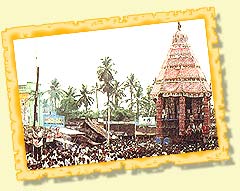
The car festival is a 10-day celebration for the small town of Ariyalur. The festival starts with the day of "Srinavame" in the month of Chithirai or Panguni (March-April). The grand event of Eganthem Sevai for Varatharajapermual is on 10th day of festival. The festival attracts people from all over the state of Tamil Nadu.
The temple is also famous for the Puraittasi Saturdays. Every year in the month of 'Puraittasi' (September), special Pujas, 'Arathanai', 'Abishekams', etc are done on the four Saturdays. This also is a major attraction of the Kaliyaperumal tem
How to get there ?
Air - The nearest airport is at Trichy.
Rail - Ariyalur is well connected by rail with all the major cities within cities.
Road - Ariyalur is accessible by road with the important places within and beyond the state. Ariyalur is located 250-km south of Chennai and 60-km from Trichy towards northeast.
-
Karthigai Deepam Festival:
Karthigai Deepam Festival - Tamil NaduKarthigai Deepam is the oldest festival of South India , which is also the most elaborate and the most important festival. Karthigai Deepam falls in the Tamil month of Karthigai when the star Krithigai is on the ascendant and usually occurs on a full moon day. This festival is also called as "the Festival of Lights".
Speciality Of The Month :
The month of Karthigai is of special importance to Tamil people, which derives its name from the star 'Krithigai'. Lord Shiva, with His divine light, created Lord Muruga, in this month.
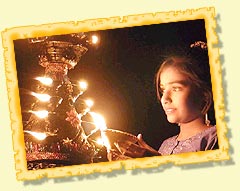
The Legend Behind The Festival :
The popular legend behind the celebrations goes like this- Once upon a time the Devas, the heavenly immortals, put in their best possible efforts to have a complete Darshan of Lord Shiva. During this process Lord Brahma took the form of a swan and Lord Vishnu in the form of a boar conducted an extensive search in the sky and in the neither world did they find him.
Lord Shiva asked Lord Brahma and Lord Vishnu to find out the exact location of his head and his feet. Since Lord Shiva took a gigantic form, they were not able to find him anywhere. Then Lord Shiva appeared before them in the form of a flaming light whose ends cannot be defined on the hill of Thiruvannamalai. Therefore, this festival is also known as Annamalai Deepam. Here, a special torch is lighted on the zenith of the hill and it is believed that Lord Shiva's Jyoti will be visible on this day. The festival is celebrated in a special manner in Thiruvannamalai.
Lord Muruga took the form of six babies in a lake called "Saravana Poigai". On this day, Parvati (his mother) united all his six forms and so Lord Muruga has six faces. Special pujas are performed to Lord Muruga.
Antiquity Of The Festival :
Evidence from Tamil literature proves that this festival is one of the oldest in the state. In ancient Tamil literature, the oldest available work Tolkappiyam gives in concise verse form rules for Tamil grammar as well as other topics. Scholars agree that this work dates back to 2,000 or 2,500 BC. In one of the formulae Tolkapiyar in his treatise uses the phrase "like the lamp's flame pointing upwards." This phrase, says one of the commentators, refers to the beacon lit on the Annamalai Hill, which burns brightly without flickering in the wind, and flares up towards the sky.
In another epic "Jeevakachintamani" written by a Jain poet, Thiruthakka Thevar, the poet describes how people celebrated the Karthigai Deepam festival. In other ancient Tamil literature of the Sangam period, the Karthigai Deepam festival is described vividly.
In "Karnarpadu", the poet in one of the stanzas, describes how in the Tamil month of Karthigai (is ii Kartik month!) during the time of the Krithigai star, the lamps lit by people blossomed on earth, bringing rain in its wake. In another Tamil work, the "Kalavazhi Narpadu" dating back to the third Sangam period (after 1,000 BC) the poet says, "In the battle the blood oozing out from the dead soldiers' bodies is like the red coloured flame of the lamps lit during Karthigai Deepam festival". In another Sangam work, "Pazhamozhi", in stanzas ending in proverbs, one stanza ends with this phrase, "like the beacon on the Hill."
A Longer Deepavali Celebration :
This festival is considered as the extension of the Deepavali festival. In some houses, they double the number of lamps every day from the day of Deepavali and this way, they end up with a number of lamps on the day of Karthigai Deepam.
On this day, people clean their houses and draw 'Kolams' (Rangoli) in front of the house and also place some lamps on it. They place the lamps ('Agal') in the puja room and light them and after the 'Deeparathana' (puja) the lamps are moved to the different places in the house. The lamps glow all over the streets on this day.
Celebrations At Tiruvannamalai :
Karthigai Deepam is the most important festival, when devotees walk round the hill and worship the Bharani Deepam, which is lit early in the morning on the final day of the festival, in the sanctum sanatorium. The Deepam is lit in a gigantic, circular metal vessel that can hold about 2,000 litres of ghee. It is five and half feet in height and five feet in diameter. For making the wick, 30m of 'Ghada' cloth is used and is burnt with 2 kilos of camphor on the night of 'Karthigai Pournami'. The Jyoti can be sighted from nearly 35-km around.
The lighting of the beacon on the top of the hill is the culmination of ten days of hectic activity in the temple town. The lighting of the Maha Deepam will take place simultaneously with "Deeparadhanam" to the five deities in the temple at the foot of the hill.
Kavadi Festival
The most potent propitiatory rite that a devotee of Lord Muruga undertakes to perform is what is known as the "Kavadi". The benefits that the devotee gains from offering a Kavadi to the Lord are a million fold greater than the little pain that he inflicts upon himself.
Generally, people take a vow to offer the Lord a Kavadi for the sake of tiding over a great calamity. Though this might on the face of it appear mercenary, a moment's reflection will reveal that it contains in it the seed for the supreme love for God. The worldly object is achieved, no doubt, and the devotee takes the Kavadi; but after the ceremony he gets so God-intoxicated that his inner spiritual chamber is opened. This is also a method that ultimately leads to the supreme state of devotion.
The Kavadi :
The 'Kavadi' varies in shape and size from the simple shape of a street hawker's storehouse (a wooden stick with two baskets at each end, slung across the shoulder) to the costly palanquin structure, profusely flower- bedecked and decoratively interwoven with peacock feathers. In all cases the Kavadi has a good many brass bells adorning it and announcing it as the Kavadi-bearer draws it along. As, very often, the Kavadi bearer observes silence; the bells are the only eloquent signs of a Kavadi procession.
The two baskets hanging at either end of the Kavadi will contain rice, milk or other articles that the devotee has vowed to offer to Lord Muruga. The more devout among them, and especially those who do it as a 'Sadhana' (meditation), collect these articles by begging. They travel on foot from village to village, and beg from door to door. The villagers offer their articles directly into the basket of the Kavadi.
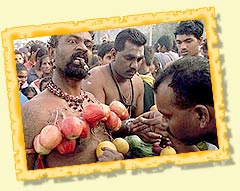
The Kavadi-bearer continues begging until the baskets are full or the avowed quantity is reached, and then offers the Kavadi to the Lord. Some keen devotees undertake to walk barefooted from home to one of the shrines of Lord Muruga, bearing the Kavadi all the way, and collecting materials for the offering. He has to walk a hundred miles sometimes! The people who place the articles in the baskets also receive the Lord's blessings.
The Kavadi-Bearer :
The Kavadi-bearer is required to observe various rules between the time he takes up the Kavadi and the day of the offering. He has to perform elaborate ceremonies at the time of assuming the Kavadi and at the time of offering it to the Lord. He also puts on the dress of a 'Pandaram', a Shaivite mendicant. It consists of a saffron-coloured cloth, a scarlet conical cap, and a cane silver-capped at both ends. Lord Shiva, the Supreme Pandaram, Himself loves to wear this dress. The Pandaram lives on alms only. The Kavadi-bearer's bare chest is covered with several 'Rudraksha Malas' (rosaries).
The Kavadi-bearer observes celibacy. He takes only pure, Satwic food; he abstains from all sorts of intoxicating drinks and drugs, He continuously thinks of God. Many of the Kavadi-bearers, especially those who do it as a spiritual Sadhana, impose various sorts of self-torture upon themselves.
Celebrations:
The Kavadi festival is celebrated at all shrines of Lord Muruga. Dancing in a hypnotic trance to the rhythm of drums, devotees of Muruga carry the Kavadi all the way up the Palani hills to fulfill their vow. Ettukudi Kavadi Festival is a famous festival celebrated during the months of April-May. Devotees from places and villages around this temple come here with Kavadis, milk pots, coconuts, cocks and goats. This is a major crowd pulling festival where one can see the true Tamil culture in its habitat.
-
Natyanjali Dance Festival
Festivals have great value in Chidambaram. The Natyanjali festival dedicated to the Cosmic Dancer (Lord Shiva) is celebrated every year during February-March. Lord Nataraja, according to Hindu mythology is the cosmic dancer. He is also called "the Lord of Dances".
Natyanjali festival opens on the auspicious occasion of the Maha Shivaratri day and of course in the right kind of venue - the 'Prakara' of the Chidambaram temple. The magnificent temple dedicated to Lord Shiva, built a thousand years ago, provides a beautiful backdrop for the event. The setting is truly divine-Chidambaram's gold-roofed temple, with pillars depicting Lord Nataraja in 108 poses from Bharatanatyam - Tamil Nadu's classical dance.
An Oppurtunity For All :
This is an opportunity for all dancers, from all over India, to perform and to pay their tribute to Lord Nataraja. Natyanjali festival is jointly organised by The Department of Tourism, Government of Tamil Nadu, The Ministry Of Tourism, Government of India and The Natyanjali Trust, Chidambaram. The festival lasts for 5 days.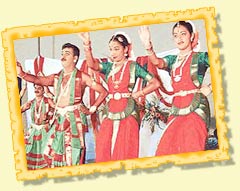 This dance festival at Chidambaram brings together all the prominent dancers of India with an enchantment and elation, which shone in their eyes and evocative Abhinaya as they offered their dance to the great divinity, Lord Nataraja. To many of them it is like a dream come true, to be able to perform in the vicinity of the sanctum sanctorum of Lord Nataraja himself, whose 'Padams' and 'Varnams' they often dance upon creating an imaginary figure of the Lord.
The Natyanjali Dance Festival is designed to promote a universal message of "Unity in Diversity" conveyed in the universal language of music and dance. Its purpose also is to both educate and entertain the audience.
This dance festival at Chidambaram brings together all the prominent dancers of India with an enchantment and elation, which shone in their eyes and evocative Abhinaya as they offered their dance to the great divinity, Lord Nataraja. To many of them it is like a dream come true, to be able to perform in the vicinity of the sanctum sanctorum of Lord Nataraja himself, whose 'Padams' and 'Varnams' they often dance upon creating an imaginary figure of the Lord.
The Natyanjali Dance Festival is designed to promote a universal message of "Unity in Diversity" conveyed in the universal language of music and dance. Its purpose also is to both educate and entertain the audience.
How to get there ?
Air - The nearest airport is at Trichy, at a distance of 160-km.
Rail - The railway station is a 20-minute walk southeast of the Nataraja Temple. Express and passenger trains leave for Chennai four times daily, Kumbakonam, Thanjavur twice daily, Tiruchirappalli and Madurai.
Road - Chidambaram is well connected by road with Chennai, Pondicherry, Madurai, Thanjavur, etc.
-
Pongal Festival
A majority of the population of India depends on agriculture. As a result, most of the festivals are also related to the agricultural activities of the people. These festivals are celebrated with different names and rituals in almost all the states of India. Pongal is an important festival of Tamil Nadu, which is celebrated to mark the withdrawal of the Southeast monsoons as well as the reaping of the harvest. It falls in the month Thai and is strictly a rural festival.
The Legend Behind The Celebrations :
There are few interesting legends behind the Pongal celebrations. The most popular among them related to the celebrations of the first day of the Pongal festival goes like this - Lord Krishna lifted the Govardhan Mountain on his little finger to shelter his people and save them from being washed away by the rains and floods.
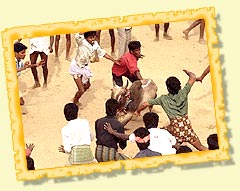 According to another the third day of Pongal is celebrated because Lord
Shiva once asked Nandi, his bull, to go to earth and deliver his message to
the people - to have an oil bath every day and food once a month. But Nandi
got it all mixed up when he delivered the message, and told the people that
Shiva asked them to have an oil bath once a month and eat every day. Shiva
was displeased, and told Nandi that since the people would now need to grow
more grain, Nandi would have to remain on earth and help them plough the
fields.
According to another the third day of Pongal is celebrated because Lord
Shiva once asked Nandi, his bull, to go to earth and deliver his message to
the people - to have an oil bath every day and food once a month. But Nandi
got it all mixed up when he delivered the message, and told the people that
Shiva asked them to have an oil bath once a month and eat every day. Shiva
was displeased, and told Nandi that since the people would now need to grow
more grain, Nandi would have to remain on earth and help them plough the
fields.
Mattu Pongal is also called "Kanu Pongal", and women pray for the welfare of their brothers. This is similar to the festivals of Raksha Bandhan and Bhai Dooj celebrated in some states of North India.
About The Festival :
The festival is celebrated for four days and the celebrations on the first day of the Tamil month Thai and continues for the three days. The month of Thai is supposed to be very auspicious for every kind of activity. The Sun is worshipped for his rays are responsible for the life on earth.
It is the biggest harvest festival, spread over four days. 'Bhogi' is celebrated on January 13, 'Pongal' on January 14, 'Mattu Pongal' on January 15, and 'Thiruvalluvar Day' on January 16. Thiruvalluvar has done a great contribution to Tamil literature with 'Thirukkural'. There are 1,330 verses in this work and they talk about all aspects of life.
In fact, the name of the festival is derived from Pongal, a rice pudding made from freshly harvested rice, milk and jaggery. The first day, "Bhogi Pongal", is a day for the family. "Surya Pongal", the second day, is dedicated to the worship of Surya, the Sun God. The third day of Pongal, "Mattu Pongal", is for the worship of the cattle.
Cattle are bathed, their horns polished and painted in bright colours, and garlands of flowers placed around their necks. Pongal is associated with cleaning and burning of rubbish, symbolizing the destruction of evil.
All the four days of Pongal have there own individual significance. On the first day, delicious preparations are made and homes are washed and decorated. Doorways are painted with vermilion and sandalwood paste with colourful garlands of leaves and flowers decorating the outside of almost every home. On this day 'Bhogi' or the Rain God is worshipped.
Rituals Followed :
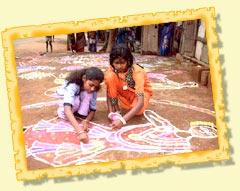
A typical traditional Pongal celebration has a number of rituals attached to it. The place where the Pongal Puja is to be conducted is cleaned and smeared with dung, a day prior to the festival. People generally choose an open courtyard for this purpose.
'Kolams' (Rangoli) generally drawn with rice flour are special to the occasion. The idea behind using rice flour is that the insects would feed on it and bless the household. At the centre of it a lump of cow dung holds a five-petal pumpkin flower, which is regarded as a symbol of fertility and an offering of love to the presiding deity. In a similar way the houses are also cleaned, painted and decorated. Kolams (Rangoli) are made in the front yards of the houses and new clothes for the whole family are bought to mark the festivities. Even the cattle are gaily caparisoned with beads, bells and flowers-their horns painted and capped with gleaming metals.
The Tempting Recipes :
Sweet rice, known as "Pongal", is cooked in a new earthenware pot at the same place where puja is to be performed. Fresh turmeric and ginger are tied around this pot. Then a delicious concoction of rice, Moong Dal, jaggery and milk are boiled in the pot on an open fire. This Pongal, according to ritual, is allowed to boil and spill out of the pot. Pongal, once ready, is offered to God first, on a new banana leaf along with other traditional delicacies like Vadas, Payasam, etc. Besides this, sugarcane, grain, sweet potatoes, etc are also offered to the Sun God.
Processions:
A procession is taken out from the Kandaswamy (also spelt as Kandaswami) Temple in Chennai. In Madurai, Tanjore and Tiruchirrapalli, where Pongal is known as Jellikattu, bundles of money are tied to the horns of bulls, and villagers try and wrest the bundles from them. Community meals are made from the freshly gathered harvest and enjoyed by the entire village.
-
Tea & Tourism Festival, Ooty
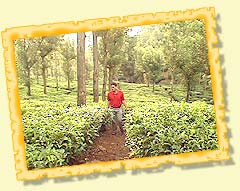
Akin to the nectar of the Gods is the Camellia Sinensia, which is a bush that gives fragrant amber ambrosia-a refresher and stimulizer. In other words, TEA.
Commercial plantations came into existence in the Nilgiris around 1853, though tea plants were thriving in Tamil Nadu earlier to this. South Indian Tea has gained recognition far and wide. India is the fifth largest tea-producing belt in the world after China. In 1991, south India exported 50 million kg. to over 30 countries.
The Celebration Of Tea :
The major tea growing areas in the South are the Nilgiris and the Anamalais High Ranges, Peermedu-Vandiperiyar belt and Wynad in Kerala and a few in Karnataka.
The Annual Tea and Tourism Festival is celebrated in the Nilgiris in the months of January/February jointly by the Department of Tourism, Government of Tamil Nadu and Ministry of Tourism, Government of India. The festival is held for 3 days and varieties of tea are put on display. Visitors can also taste and select from the wide varieties of tea available.
Cultural programs, visits to Tea Estates and factories, fun and frolic etc., mark the celebrations. Come to the Nilgiris, during this festival, when tea lovers from all over the world converge. An occasion not to be missed!
How to get there ?
Air - The nearest airport is at Coimbatore (100-km).
Rail - Udhagamandalam on the narrow gauge railway is connected to Mettupalayam, which is directly connected to Coimbatore and Chennai on the broad gauge.
Road - There are regular bus services connecting Udhagamandalam to Coimbatore, Trichy, Bangalore, Madurai, Kanyakumari, Mysore, Calicut, Tirupati etc.
Fairs & Festivals in Tamil Nadu
India Tour Packages







